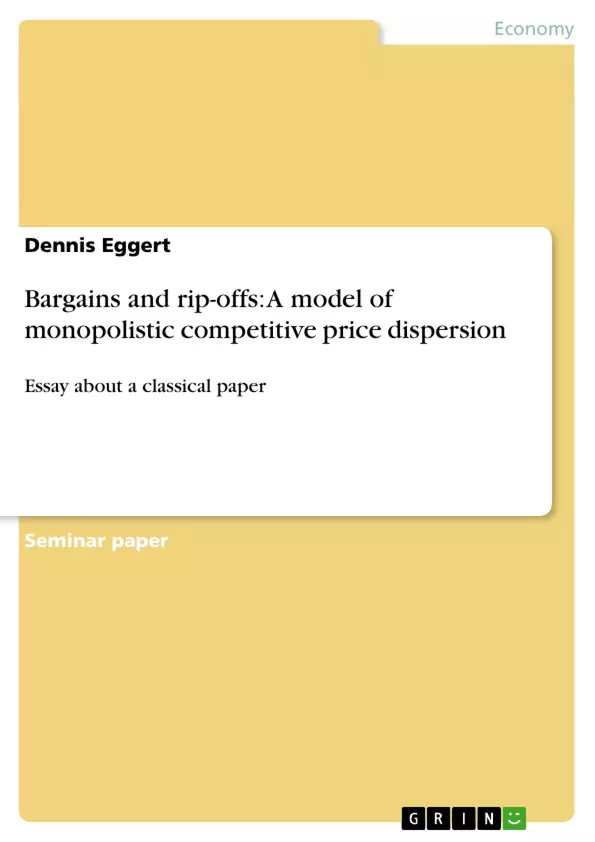The main issue in the article is the derivation of a model in which prices can differ in equilibrium, even though the goods are homogeneous and there is asymmetric information in the market. The reason for this price dispersion is caused by consumer heterogeneity. Salop and Stiglitz explain, that “because of differences in preference or ability, some agents perform much better than others in market decisions.” To model this kind of heterogeneity they assign different costs of gathering certain information to the consumers. For simplicity they part the consumers in two groups: The first one consists of low-cost information gatherer and the other group has higher cost to gain complete information. For further simplicity there are just two levels of information: to be completely informed or to be not informed at all. Furthermore the costs to become an informed consumer are fixed. The differences in information in this model regard the locations of the shops. All consumers know about all prices that are in the market, they just do not know where the shop with a certain (the lowest) price is.
The shops on the other hand have complete information about the market. They know about the differences between the consumers and can compute the demand that will occur, when they ask a certain price. So they face a trade-off between higher prices and lower demand. It is important to state why there is a possibility of raising the price and not to loose all demand like it would be in a perfect market. When the rise in price is not too high, it does not pay for the high-cost information gatherer to become completely informed. Their expected loss by buying randomly either in low- or high-priced shops is lower than the fixed cost of gathering the information.
All together this consumer heterogeneity and the fully informed shops can lead to price dispersion in equilibrium, even though the goods are homogeneous and there is the difference in information between the actors.
Inhaltsverzeichnis (Table of Contents)
- Summary
- Placement in the literature
- What led to Salop's and Stiglitz's paper?
- The contribution of the paper
- Other research in that time
- Other models of price dispersion
- How did the literature proceed after the paper?
- Today's relevance
- Critique
- References
Zielsetzung und Themenschwerpunkte (Objectives and Key Themes)
The article aims to develop a model explaining price dispersion in equilibrium, even with homogeneous goods and asymmetric information. The model highlights the significance of consumer heterogeneity in driving this dispersion.
- The role of consumer heterogeneity in price dispersion
- The impact of asymmetric information on market outcomes
- The implications of consumer information costs for price formation
- The equilibrium analysis of price dispersion in a monopolistically competitive market
- The evolution of economic models addressing information asymmetry
Zusammenfassung der Kapitel (Chapter Summaries)
- Summary: The article introduces a model where price dispersion exists in equilibrium due to consumer heterogeneity and asymmetric information. The model focuses on two consumer groups with differing information acquisition costs, leading to varying levels of information about shop locations and prices.
- Placement in the literature: This section places Salop and Stiglitz's work within the broader context of economic theory, emphasizing its contribution to addressing limitations of traditional models. It discusses the historical development of economic models addressing information asymmetry, starting with Stigler's work on "The economics of information" and continuing with Akerlof's seminal paper on "The markets for Lemons."
- What led to Salop's and Stiglitz's paper?: This section elaborates on the evolution of economic thought regarding information asymmetry, highlighting the contributions of Stigler and Akerlof in introducing the concept of information costs and market failures due to hidden information.
- The contribution of the paper: This section highlights the key contribution of Salop and Stiglitz's paper, which develops a model that explains price dispersion in equilibrium despite asymmetric information. It emphasizes the significance of this contribution in the context of contemporary research focusing on information asymmetry and its impact on market outcomes.
- Other research in that time: This section discusses the broader research landscape in the field of economic modeling, with a focus on incorporating information asymmetries into market analysis. It presents a comprehensive overview of other researchers and their contributions to this burgeoning field.
Schlüsselwörter (Keywords)
The paper focuses on key topics like consumer heterogeneity, asymmetric information, price dispersion, monopolistic competition, equilibrium analysis, and information costs. It highlights the interplay of these factors in shaping market outcomes and their implications for economic theory.
- Arbeit zitieren
- Dennis Eggert (Autor:in), 2006, Bargains and rip-offs: A model of monopolistic competitive price dispersion, München, GRIN Verlag, https://www.grin.com/document/76533



